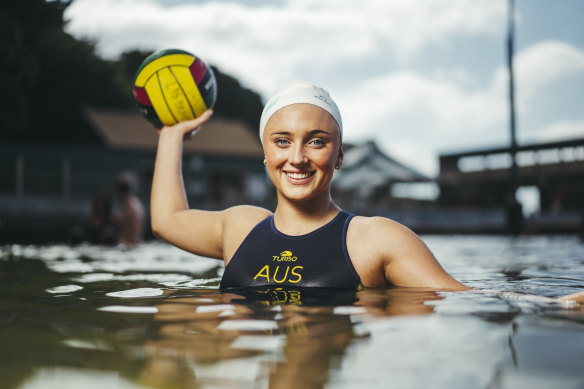- Exclusive
- National
- Kids’ sport
This was published 1 year ago
Active children do better at school. So how do we keep teens in sport?
By Mary Ward
It’s a time when many students clear their schedules to focus on academics, but research suggests the grades of adolescents involved in sports throughout high school are unlikely to take a hit. In fact, they may even improve.
Researchers at the University of Sydney analysed the sports participation and academic performance of more than 4200 students from the age of four through to the age of 21 using data from the federal government’s Longitudinal Study of Australian Children.

Lily Dunn received an ATAR of 92.7 last year while training with the under 20s Australian water polo squad.Credit: Dion Georgopoulos
Controlling for various factors – including disability, socio-economic status and attending a private school – the researchers found participation in sport was associated with higher NAPLAN scores, school attendance, and a higher likelihood of university admission.
Individual sports – such as dance, tennis or swimming – were more closely associated with higher literacy NAPLAN scores while participation in any type of sport was associated with higher numeracy scores. Only playing a team sport was linked to lower odds of being absent from school without permission.
Lead researcher Dr Katherine Owen said following children’s participation in sport and academic outcomes over the course of their school life meant it was more reasonable to think the previously established link between playing sport and doing well in the classroom was not coincidental.
“We have shown kids who continue playing sports through their childhood and into adolescence perform better academically,” she said, noting the study allowed researchers to compare a child’s performance over time, showing an increase in academic outcomes while a child continued playing sport.
Owen said there could be several reasons why different types of sports were associated with different types of academic achievement and school success.
“Team sports foster more social connections, and we saw those children were less likely to be absent from school,” she said.
“While individual sports require more dedication, you’re training by yourself. It’s also possible that certain types of kids go for different types of sports.”
While previous studies have shown that children who participate in sport are more likely to perform well academically, this study is believed to be the first to show this occurring over the course of a child’s development.
A 2017 Australian Sports Commission report identified several barriers to secondary students playing sport, including parents being unable to provide the time and money required, increasing time demand for extracurricular activities (such as a part-time job, or additional social activities), and adolescents feeling less able to join a community team when others their age had more experience.
“There are so many barriers and reasons for kids dropping out,” said Owen.
“But a lot of the research we have done has shown kids drop out because it gets too competitive. The sports themselves need to work at providing more social games for kids of that age.”
Victoria University sport participation researcher Dr Aurelie Pankowiak, who was not involved in the study, said the data supported existing research.
“But what we still don’t quite know is the direction of the relationship between these positive outcomes and participation in sport,” she added.
“We are not sure if it’s because kids are doing better at school and having these positive outcomes that they might be more likely to participate in sport.”
Pankowiak agreed that sporting bodies needed to dedicate resources to helping clubs retain children through high school.
As well as providing more opportunities for social sport – particularly leagues which did not have a training commitment on top of a weekend game – she said the intense and sometimes abusive culture that can emerge as sports leagues become more competitive also needed to be evaluated.
“We need to make sure the environment in the club is safe and respectful,” she said.
Lily Dunn, an 18-year-old water polo player who trains with the national side, said many schools encouraged students to take a break from sport during year 12.
“Which I obviously didn’t listen to,” she said, adding that there was a “massive drop-off” in girls at her school doing sport from about year 10 onwards.
For Dunn, who received an ATAR of 92.7 and will start a double-degree in business and exercise science at UTS this month, sticking with water polo was largely driven by her goals in the sport.
But, she said the training schedule also helped keep her focused when studying, with revision and training providing respite from one another throughout her busy weeks.
“I’ve said this to heaps of my friends who were feeling so much anxiety and stress during the HSC, I’d encourage them to find something to do: sign up to Pilates, just do something,” she said.
“It was such a relief for myself, and I don’t think it needed to be at the elite level that I was at. It was more having at least three or four hours a week dedicated to a commitment – not a walk or something that you can say you are too busy for – that really helped.”
Start the day with a summary of the day’s most important and interesting stories, analysis and insights. Sign up for our Morning Edition newsletter.